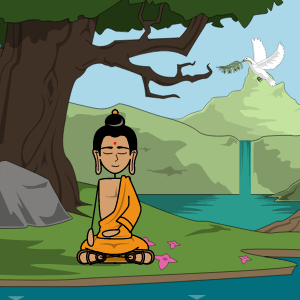Budisma Fakti

Jūs varat atrast šo montāžas šādās rakstiem un resursi:

Pasaules Reliģiju Mācīšana
Autore Liane Hicks
Mācības par dažādām pasaules reliģijām ir būtiska pasaules vēstures, ģeogrāfijas un kultūras izpētes sastāvdaļa. Reliģijas studijas ir spēcīgs veids, kā studenti var uzzināt vairāk par pasaules vēsturi un ticības sistēmām, kas tūkstošiem gadu ir ietekmējušas cilvēka kultūru.

Budisms: Izcelsme un Vēsture
Autore Liane Hicks
Budismu praktizē vairāk nekā 500 miljoni cilvēku visā pasaulē, un tas ir ceturtā lielākā reliģija pasaulē. Budisms ir aptuveni 2500 gadus vecs un sākās 6. gadsimtā, pamatojoties uz Budas mācībām. Tā ir reliģija, kuras centrā ir miers un klusums, kā arī morālas un labas dzīves nozīme.
Montāžas Apraksts
Palūdziet studentiem aprakstīt un ilustrēt dažādus faktus par budismu. Viņi var atbildēt uz šādiem jautājumiem: Kur radās reliģija ?: Kas bija tās dibinātāji ?: Kad tā sākās ?; Kādi ir daži no galvenajiem uzskatiem ?; Kādi ir svētu priekšmetu vai simbolu piemēri?: Kā tā sekotāji pielūdz / pielūgšanas namus; Kas ir tās garīgie vadītāji?
Montāžas Teksta
- POPULATION TODAY
- Over 500 Million Followers
- Ancient India / Lumbini Province, Nepal
- Izcelsmes vieta
- GADI tas sākās
- 6th Century BCE
- SPIRITUAL LEADERS
- “I believe that the very purpose of life is to be happy. From the very core of our being, we desire contentment. ... Since we are not solely material creatures, it is a mistake to place all our hopes for happiness on external development alone. The key is to develop inner peace.”
- All over the world but mainly in East and Southeast Asia
- Buddhists represent about 7% of the world's population. People practice Buddhism throughout the world but most are located in east and southeast Asia in China, Nepal, India, Sri Lanka, Myanmar, Cambodia, Laos, Thailand, Korea, and Japan.
- Budisms tika dibināta Siddhartha Gautama, kurš bija Hindu princis dzimuši Lumbini provincē netālu Himalaju kalnos Senajā Indijā, mūsdienu Nepālā.
- Siddhartha Gautama dzimis ap 623 gpmē. Viņš ceļoja pa visu Indiju, mācot savas idejas par iekšējo mieru un to, kā izbeigt ciešanas. Viņš ir pazīstams kā Buda. 3. gadsimtā pirms mūsu ēras Mauryan Indijas imperators Ašoka Lielais padarīja budismu par Indijas valsts reliģiju. Kaut arī budisms Indijā galu galā samazinājās, dažu nākamo gadsimtu laikā budisms izplatījās ārpus Indijas uz austrumu un dienvidaustrumu Āzijas lielāko daļu.
- Dibinātāji
- While there are different sects of Buddhism, the Dalai Lama is the spiritual leader of the Tibetan Buddhists. He was awarded the Nobel Peace Prize in 1989 and the U.S. Congressional Gold Medal in 2007. Dalai Lama means Ocean of Wisdom. Other Buddhist leaders include monks, who are usually men, and nuns, who are women.
- HOUSES OF WORSHIP
- FAKTI PAR budismā
- SYMBOLS & OBJECTS
- Ticējumi
- Right Concentration
- The Eightfold Path
- Right Understanding
- Right Thought
- Siddhartha was a Hindu prince. Upon discovering sickness, old age, and death outside the palace walls, he left his privileged life to meditate and seek an answer to the root causes of human suffering. He achieved enlightenment at the age of 35 after meditating for several days under what is known as the Bodhi tree and became the Buddha. He taught his followers that the way to Nirvana was by following the Four Noble Truths and the Eightfold path.
- A Buddhist temple or monastery is a place of worship for Buddhists. They include a vihara, chaitya, wat, pagoda, and stupa. Stupas are dome-shaped structures erected as Buddhist shrines. They contain relics, typically the ashes of Buddhist monks, and are used by Buddhists as a place of meditation.
- Mala are prayer beads used in Buddhism and other religions. Prayer wheels contain a tightly scrolled paper of a mantra or prayers. When spun, the prayers sent out multiply. Other sacred objects are prayer bells, conch shells, singing bowls, statues of the Buddha, and the Om which represents the ultimate reality, consciousness, or Atman.
- The Buddha taught Four Noble Truths: 1) All life involves suffering; 2) Selfish desires are a cause of suffering; 3) People can end their suffering by giving up selfish desires and reach Nirvana; 4) Following the Eightfold Path will help one to reach Nirvana. Buddhists also believe in reincarnation. People are reborn after dying and go through cycles of birth, living, death, and rebirth. They believe that one should do no harm to any living thing.
- Right Mindfulness
- Right Effort
- Right Livelihood
- Right Action
- Right Speech
Izveidoti vairāk nekā 30 miljoni stāstu shēmu







